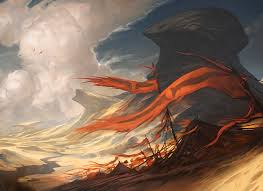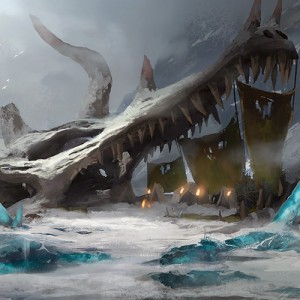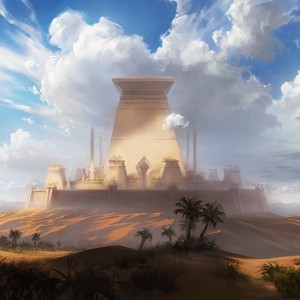Welcome back! When last I left you, I was lamenting the lack of fun in Khans of Tarkir limited. Since then I’ve jammed six drafts and have started to come around on the format. I still think the games are incredibly—sometimes overly—complex, and Abzan mirror matches are painful to play, but overall I’ve been enjoying the variety of decks that are possible. I’m excited to make the trip down to Orlando for the Grand Prix this weekend.
So far I have one overwhelming takeaway about playing Khans limited: mana. You need mana. Lots of it. In many colors. Now obviously mana is going to be a tricky element of any multicolor format, but in Khans it is essential that you have not just the right colors of mana but also the right amount. And the right amount is “as much as possible.” If you want to survive and win in Khans you have to hit your lands drops on time. Absolutely your first five, and preferably six, seven, and up.
The biggest element of the format that demands mana is morph. The mechanic inherently pushes you to have three mana on turn three, but on top of that the way Wizards priced the morph flip costs, you have to have five mana on turn five. Once you hit five mana, the range of possible morphs that you can bluff increases dramatically. Opponents will often be happy to block your attacking morph if you only have four mana available, but if you have five they really won’t want to block unless they have cards to interact with a large flipped morph.
The upshot of this is that playing 18 lands in your 40-card deck is almost mandatory. I think you need a really good reason to run less than 18 in any deck you play, even an aggressive one. Playing an extra land in your deck reduces your chances of missing a land drop in the early- or mid-game. It also gives you room to run enough colored sources for three colors (or more). Sure, you have one less spell in your deck, but the cards in Khans have such high power level on average that you will have plenty of potency in your deck despite running only 22 business spells.
The big danger of playing extra lands is running out of things to do with all the mana you have, but morph takes care of that. Each creature that you play face down and then later flip up is really two separate spells. To get full value out of a morph, you really are committing to spending two full turns worth of mana on it. One of my favorite morphs in the set is Wooly Loxodon. The 6/7 body is fantasic in a format full of ground attackers. When you flip it on turn six, you affect the board and use your mana without spending a card. That means even if you are low on business spells because of all the lands you’ve drawn, you can still make meaningful plays.
Even outside of morph, this set costs a lot of mana. Look at the removal. Red doesn’t even have a cheap burn spell unless you count the rare Crater’s Claws, which can potentially be Shock or Lightning Strike. If a red mage wants to burn something in Khans, she has to spend four or five mana to do it. Black gets the all-star Debilitating Injury and potentially Murderous Cut, but most of its removal also costs a chunk of mana to cast. The only two removal spells that can reliably remove a big creature for less than three mana are Suspension Field and Savage Punch. Speaking of which, Savage Punch has really impressed me. The first time I cast it, I was like “whoa, this only costs two?!” I blame clunky fight spells like Time to Feed and Hunt the Weak.
I think the intense pressure that Khans puts on your mana is a big part of my frustration with Abzan and the outlast mechanic. There is already so much to do with your mana that paying for outlast can be difficult. Cheap removal seems especially valuable in an Abzan deck just so you can interact with the board while also building up your outlasters for the long haul.
Going back to my criticism last week, playing an Abzan deck really overloads you with strategic choices on every turn, and questions about how you sequence lands and how you spend your mana each turn get more difficult when you also have to take outlast into account. On the one hand, outlast is just an additional option that you can use if you don’t have other plays to make, and that’s nice. But on the other hand, it seems like outlasting on early turns can be crucial to your long-game strategy with the deck. I suspect there will be many Abzan turn fives where future game concerns make it the right play to outlast your Disowned Ancestor and play a morph rather than using your mana on a bigger spell. That often may even preclude you from attacking with a morph and five mana up, because you simply can’t afford to spend your mana on anything other than outlasting. I’m not sure how often that will come up, but I bet it will be a common occurrence.
Another discovery I’ve made along these lines: delve is amazing. It makes sense that in such a mana-hungry set ways to cheat on mana would be powerful. Even in a Mardu deck that makes no effort to fill its graveyard other than getting into combat, the power of one or two delve cards can be game-breaking. I had one sequence this weekend where I was able to cast both Murderous Cut and Mardu Charm with only five mana to clear out my opponent’s Bellowing Saddlebrute and Hooting Mandrills. That’s efficiency!
Once you get into actual Sultai decks that are tossing cards into the graveyard left and right, delve gets absurd. I’ve cast Treasure Cruises for one, Necropolis Fiends for two, and still had room to get a discount on a Hooting Mandrills down the line. Sultai has really impressed me as a control color. Unlike Abzan, that eventually turns the tables through +1/+1 counters and accumulated special abilities, Sultai can explode and effectively Time Walk by casting three big spells on a single turn. It feels like those crazy Arbor Colossus plus Nykthos, Shrine to Nyx turns that came up in green Theros decks from time to time.
My final thought on the mana of Khans is this: mulligan hands that are short on mana. I don’t think you can ever keep a one-land hand unless you’re down to four cards or something along those lines. Two-land hands are tricky. Most two-land hands will hit the third land drop on time, which is important, but they have a hard time hitting the fourth and especially the fifth. Unless your hand can function respectably on three mana—say because you have Debilitating Injury and a couple morphs that flip cheaply—I think you need to send those two-landers back. Going down to six cards doesn’t make it easier to hit land drops, but I suspect that most six-card three-land hands will beat most seven-card two-land hands. I’m not sure about this, but it’s something to think about.
Anyway, thank you for reading! Let me know what you think in comments. If you’ll be at GP Orlando this weekend, say hello!
Carrie O’Hara is Editor-in-Chief of Hipsters of the Coast.




